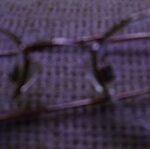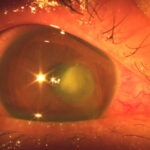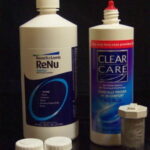Buying your first pair of glasses can seem a daunting task when faced with all those frames on the walls and listening to all those lens options. There’s a lot to consider when purchasing glasses, whether they are for you or if they’re for a child. Read on for tips to help make the process a little easier.
The Prescription
What do all those numbers on the prescription mean, anyway? It’s a good idea to ask your optometrist or eye care professional to explain the prescription to you before you leave the office. If you forget, your optician can explain it to you when you’re looking at glasses, but here’s a few basics:
-Glasses powers are measured in diopters. A -1.00 means you’re mildly nearsighted, or myopic, while a -7.00 means you’re very myopic.
-If your prescription has three numbers in a row, like this: -1.00 -.75 X 90, it means you are nearsighted or myopic, and have astigmatism.
-If yours only has one number per line, you don’t have astigmatism. Your prescription, whether nearsighted or farsighted, is considered spherical.
-OD stands for Oculus Dexter, Latin for “right eye”. OS means Oculus Sinister, or “left eye”. The right eye is always written first.
-If you need bifocals, your prescription will have a section called an “add power”. This means you need glasses for distance and for closer objects. This condition is called presbyopia, and is a part of the aging process.
Why Are There So Many Different Lenses?
Lenses come in many different styles to suit a variety of needs. If you just need glasses to see at a distance or for reading only, you’ll need single vision lenses. If you need glasses for near and far, you’ll need bifocals, trifocals, or multi-focals.
Bifocals are lined lenses that have one segment for distance and one for near. Trifocals have a third lined segment for an intermediate range, such as computer use. Multi-focals are sometimes called “no-lines” or “progressives”. These lenses have no lines and allow optimal visual acuity at all focal areas. Multi-focals are sometimes mistakenly called trifocals.
What are Lightweight Lenses?
Lightweight lenses are plastic lenses, sometimes called hi-index. The material they are made from has a higher refractive index, meaning they can bend more light than regular plastic, therefore making them thinner. There are many kinds of lightweight lenses. One of the most common is polycarbonate.
Polycarbonate is a great lightweight lens because it is also thinner and more impact-resistant than regular plastic. Polycarbonate is recommended for kids, athletes or those who want safety protection from their glasses.
Lightweight lenses are recommended for everyone, especially those with a high or heavy prescription.
What Kind of Frame Should I Choose?
No matter what style you choose, frames should be comfortable, appropriate for your lenses, and stylish.
Plastic frames are available in bold styles and colors that make a strong statement. Styles range from the palest pink to rhinestone-studded black cat eyes, and everything in-between. Classic, scholarly looks and wild shapes are both unique plastic frame statements.
Plastic frames are good for thick lenses, as they mask some of the edge thickness. They’re not a great idea for sunglasses, as they will warp if left out in the heat or stashed in a broiling hot glove box.
Plastic frames tend to slide down the nose more often than metal frames, because they usually don’t have adjustable nose pads.
Metal frames offer a lower-profile look with their thin rims and refined colors. Hues range from basic gold and silver to rose, peach, pale blues, grays and blacks. If you’d rather not announce to the world that you’re wearing glasses, a metal frame is a good choice.
Metals frames are also available in strong, titanium alloys and even flexible styles that will bounce right back from a twist that would break a regular metal frame. Metal frames are for you if you desire style and durability in your glasses.
Spring hinges are available on both plastic and metal frames. This hinge style does more to lengthen the life of your glasses than any other feature. Spring hinges are a must on children’s glasses and safety eyewear.
No matter which style you choose, the frame should fit properly. The frame should be comfortable, rest gently behind your ears and be adjusted to the plane of your nose. Temple ends that pinch and glasses that slide are common problems that can be adjusted by an optician.
Which Lens Options Should I Choose?
The basic lens options that should be on every pair of glasses are scratch-resistant coating and ultra-violet protection. All lenses can be scratched, but a coating can be applied to make the lens surface harder. Clear ultra-violet coatings filter out harmful UV rays to protect your eyes from sun damage.
Other popular options are anti-reflective coatings, tints, and films that cause the lenses to darken outdoors while remaining clear indoors.
Anti-reflective coatings reduce glare caused by reflection on the lenses. They also allow more light to reach your eye, allowing you to see more clearly. This coating is a must for computer use, extensive reading or nighttime driving.
Tints are generally light colored for comfort, or much darker for sunglasses. Tint does not protect your eyes from the sun; you must have a UV coating to avoid sun damage.
Most optical shops will have sample of all the lens and coating options available. Be sure to ask about specialty treatments like polarized and mirrored lenses.
Lastly, if a warranty is offered on your first pair of glasses, purchase it. If you’ve never worn glasses before, you’re more likely to accidentally damage the frame or scratch the lenses. In most cases the cost of the warranty is a fraction of the cost to replace scratched lenses or broken frames; you’ll thank yourself later for thinking ahead and purchasing the protection.
Care of Your Glasses
Always keep your glasses in the case provided with them. This is the best way to prevent accidents, like sitting on your glasses, which is the most common reason for replacement.
Be sure to wet the lenses thoroughly before wiping them off; this will help prevent scratching. Always use an approved cleaner and 100% cotton cleaning cloth. Don’t wipe them with paper products, kitchen towels or on your shirt, as all of these materials can cause scratching.
Bring your glasses back to the optical shop every few months for an adjustment or minor repairs. Nose pads that have turned yellow or green should be replaced. It’s a good idea to wash the entire pair in warm, soapy water once a week, especially during the summer months.
Finally, if your glasses become bent or crooked, bring them to an optical shop to be adjusted. Bending them back into shape is an exercise in opposites, and delicate parts may break easily. Repair kits can be purchased, but often the screws will not be the proper size for your specific frame. An optical shop will have all the varieties to ensure a proper repair.





